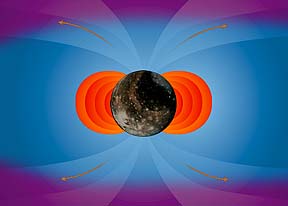This is an artist's conception of the magnetosphere of Ganymede. The trapping region or radiation belts are featured in orange.
Click on image for full size
Windows Original
Magnetosphere of Ganymede
When the Galileo spacecraft flew by Ganymede, to everyone's surprise, it measured a very strong magnetic field for the first time near any moon.
To generate a magnetic field, there must be conducting material inside. This may be provided either by iron, or by salt water. The conducting material must also be in motion. Motions are usually provided by hot convective motions of the conducting material itself.
The existence of a magnetic field provides further evidence that Ganymede is not completely frozen, but has either a warm iron core or a salty, subterranian ocean. This is completely uncharacteristic of an icy moon, and makes Ganymede unique.
The presence of a magnetic field provides for a different kind of interaction with the charged particles in the magnetic environment of Jupiter. Such an interaction might even include aurora.
You might also be interested in:
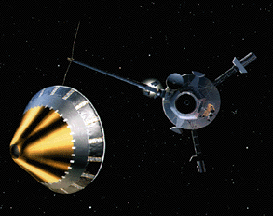
The Galileo spacecraft was launched on October 19, 1989. Galileo had two parts: an orbiter and a descent probe that parachuted into Jupiter's atmosphere. Galileo's primary mission was to explore the Jovian
...more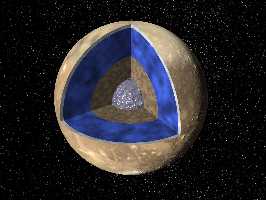
The diagram to the left shows a cutaway of the possible interior structure of Ganymede, based on recent measurements by the Galileo spacecraft. It shows a small core of metal, overlain with some rocky
...more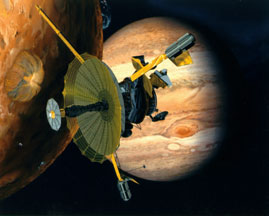
The Galileo spacecraft, which has been orbiting Jupiter since 1995, has finally reached the end of its road. On September 21, 2003, Galileo will make a fiery plunge into Jupiter's atmosphere and be vaporized.
...more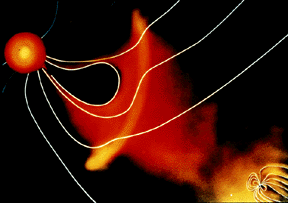
The Sun is surrounded by a "bubble" in space called the heliosphere. In a sense, we Earthlings live within the outer atmosphere of our Sun. The solar wind fills the heliosphere with energetic
...more
Amalthea was discovered by E Barnard in 1872. Of the 17 moons it is the 3rd closest to Jupiter, with a standoff distance of 181,300 km. Amalthea is about the size of a county or small state, and is just
...more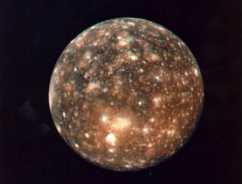
Callisto was first discovered by Galileo in 1610, making it one of the Galilean Satellites. Of the 60 moons it is the 8th closest to Jupiter, with a standoff distance of 1,070,000 km. It is the 2nd largest
...more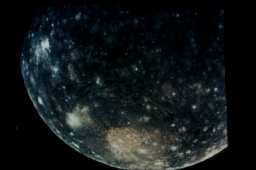
Most of the moons and planets formed by accretion of rocky material and volatiles out of the primitive solar nebula and soon thereafter they differentiated. Measurements by the Galileo spacecraft have
...more


